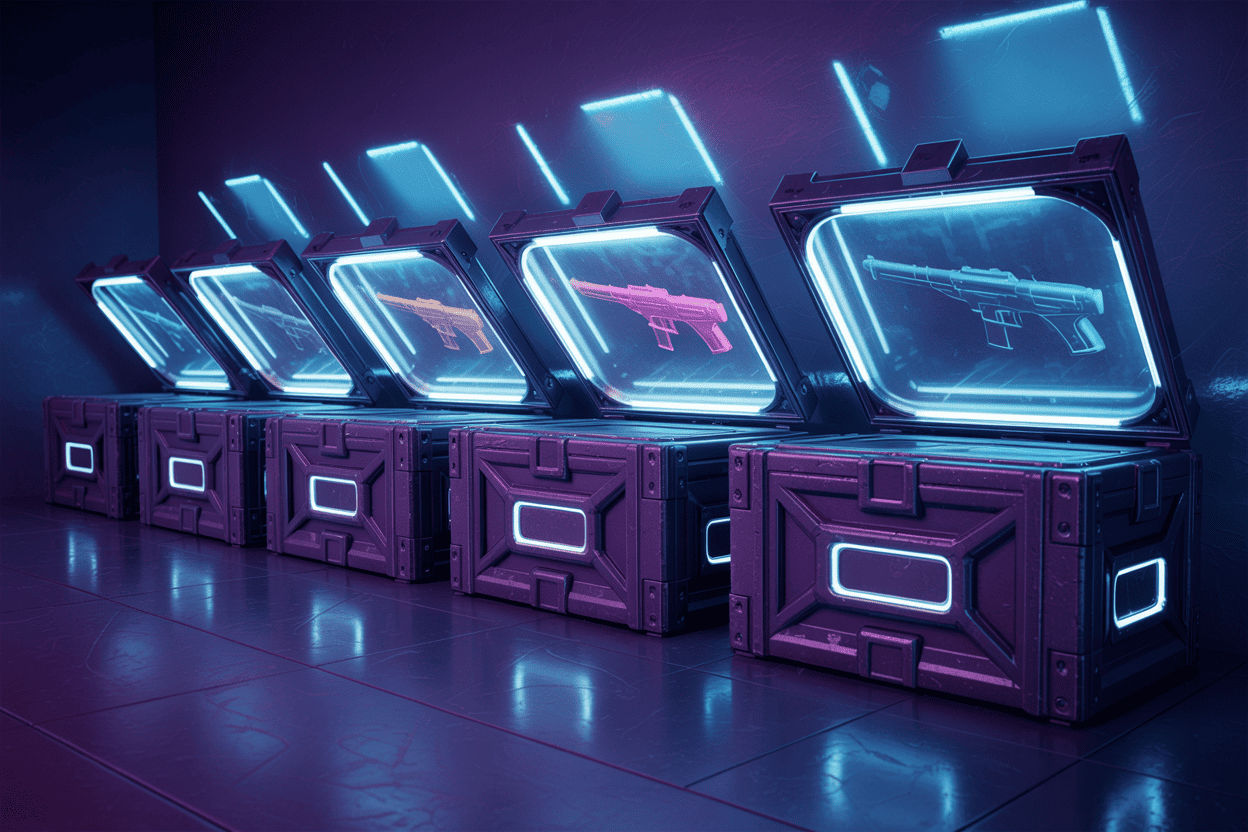
The Evolution of CS:GO Cases
Exclusive XP Team
Market Analysis & Gaming History
The introduction of weapon cases fundamentally changed CS:GO's economy and player engagement. From the first Weapon Case in 2013 to today's sophisticated collections, each release has brought new dynamics to the marketplace and redefined how players interact with cosmetic items.
The Revolutionary Beginning: Weapon Case 1
Released on August 14, 2013, the original Weapon Case introduced a concept that would become central to CS:GO's identity: randomized cosmetic rewards. This case contained 13 weapon skins across different rarity tiers, establishing the foundation for what would become a multi-billion dollar virtual economy.
The most notable skins from this inaugural case included the AK-47 | Case Hardened, with its distinctive blue patterns that would later command premium prices based on pattern variations. The Desert Eagle | Hypnotic, with its mesmerizing spiral design, became an instant classic that remains popular among collectors today.
Case Statistics: Weapon Case 1
Release Date: August 14, 2013
Total Skins: 13 weapons
Rarity Tiers: 5 categories
Most Valuable: AK-47 | Case Hardened (Blue Gem patterns)
Status: No longer dropping
Current Market Cap: $2.8M+ across all items
Game-Changing Collections: The Major Milestones
The Bravo Case (September 2013)
The Bravo Case marked CS:GO's first major collaboration with the Steam Workshop community, featuring designs submitted by players. This case introduced the legendary AK-47 | Fire Serpent, a discontinued skin that has appreciated dramatically in value due to its striking red and gold aesthetic and limited availability.
The Huntsman Case (May 2014)
Coinciding with the "The Hunt Begins" update, this case brought the M4A1-S | Atomic Alloy and introduced more sophisticated design themes. The case demonstrated Valve's commitment to regular content updates that would keep the community engaged beyond core gameplay mechanics.
The Phoenix Case (February 2014)
This case contained the iconic AK-47 | Redline, which became one of the most recognizable skins in CS:GO history. The Phoenix Case proved that clean, minimalist designs could be just as appealing as complex, detailed artwork, influencing skin design philosophy for years to come.
The Psychology of Case Opening
Beyond their economic impact, CS:GO cases introduced a psychological element that fundamentally changed how players engaged with the game. The anticipation of opening cases, combined with the rarity system and visual reveals, created a compelling experience that extended gameplay beyond matches.
This mechanic not only generated revenue for Valve but also created a secondary market where players could trade, sell, and speculate on virtual items, establishing CS:GO as one of the first games to feature a fully-realized virtual economy.
Technical Evolution and Design Improvements
As CS:GO's graphics engine improved, case contents evolved to take advantage of new rendering capabilities. The transition from simple color overlays to complex material shaders allowed for more sophisticated designs featuring metallic finishes, wear patterns, and intricate details.
The introduction of StatTrak™ technology in October 2013 added another layer of value and personalization. These kill-counting variants of popular skins commanded significant premiums and created new collecting categories within the community.
Modern Innovations and Community Integration
Recent cases have showcased increasingly sophisticated community integration. The Dreams & Nightmares Case, released in January 2022, featured entirely community-created designs selected through a competitive workshop process. This approach demonstrated Valve's commitment to involving players in content creation while maintaining quality standards.
The Revolution Case (February 2023) introduced some of the most technically advanced skins in CS:GO history, featuring complex multi-layer designs and innovative use of the Source engine's material system. These advances showed how far skin design had progressed from the simple texture overlays of 2013.
Impact on Competitive Gaming
Cases have influenced competitive CS:GO beyond mere aesthetics. Professional players often use specific skins that become associated with their playstyle and achievements, creating emotional connections between items and memorable esports moments.
Tournament organizers have leveraged case releases for marketing, with major championships often featuring special case drops or themed collections that commemorate significant events in competitive CS:GO history.
Economic Impact and Market Development
The case system created an entire ecosystem of traders, collectors, and market analysts who track price trends, pattern rarities, and float values. Third-party marketplaces emerged to facilitate trading, with some rare items commanding prices equivalent to luxury automobiles.
Steam Community Market data shows that case-related transactions have generated over $15 billion in trading volume since 2013, with Valve collecting a percentage of each transaction. This success model influenced other games to adopt similar systems, making CS:GO a pioneer in virtual item economies.
Looking Forward: The CS2 Transition
As Counter-Strike 2 emerges, the legacy case system faces both opportunities and challenges. Enhanced rendering capabilities in the Source 2 engine allow existing skins to display with improved lighting and material effects, potentially increasing their visual appeal and market value.
The transition period has created uncertainty in skin valuations, with some collectors holding positions while others liquidate inventory. Historical precedent suggests that established, high-quality skins will maintain their value through engine transitions, while newer or less distinctive items may face volatility.
Key Takeaways for Collectors
- • Early cases often contain the most valuable long-term investments due to their limited supply
- • Community-favorite designs tend to appreciate regardless of their original rarity tier
- • Technical innovations in newer cases may not always translate to higher market values
- • StatTrak™ variants consistently command premiums, especially for popular weapon types
Conclusion: A Decade of Innovation
The evolution of CS:GO cases represents more than just cosmetic additions to a video game. These virtual items created new forms of digital ownership, community engagement, and economic activity that have influenced gaming industry standards worldwide.
As we look toward the future with Counter-Strike 2, the lessons learned from a decade of case evolution will undoubtedly shape how virtual economies develop in competitive gaming. The most successful skins—those that combine aesthetic appeal with cultural significance—will continue to thrive as both gaming accessories and alternative investments in the digital age.